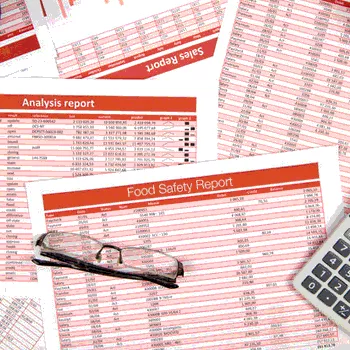Audits Offer an Opportunity to Embrace Food Safety

Whether third-party certification audits, internal audits, or customer audits, they are always an opportunity to learn and to obtain the best feedback for bringing about improvements in your business and processing facilities. So instead of being under stress, always accept them as opportunities. Still, there are certain practical tips for facing both announced as well as unannounced audits that can help reduce unnecessary stress during these times.
Many food businesses rely on only one person to manage all of the Hazard Analysis and Critical Control Points (HACCP), food safety, and quality compliance activities. If you wish to make your audit a success and want to have a better learning experience from your audit, you must ensure that everyone on the team helps prepare for the audit and implements any needed corrective actions. In any food business, food safety is not only the responsibility of one person; team work is required and will foster a food safety culture.
Before the Audit
You can probably anticipate with a reasonable degree of accuracy with whom your auditor may want to speak. Pick staff in key roles and make sure they are totally up to speed on your food safety protocols.
You could even do some role playing. With a little practice, your staff will feel far more comfortable and confident by the time the auditor arrives. So, rehearse the audit. It really helps a lot, but sometimes you don’t pick up on the little things until you put yourself in the shoes of an auditor.
Each department should have its own set of questions expected from the auditors and be ready with answers and supporting documentation. This can be rehearsed in advance to gain confidence.
During the Audit
First of all, identify the different elements of the food safety system at your factory site and the best suited person to take responsibility for each of these elements.
Second, if you observe something that is not right while walking the site or reviewing documents and records with your auditor, don’t just cross your fingers and hope that the auditor doesn’t spot it. Flag it and tackle it straight away. It does not show a weakness in your system, rather, it’s a way to show the auditor that identifying and resolving issues promptly is part of your company’s culture.
The third thing is to be honest, especially when answering the auditor’s questions. If you don’t know the answer, and there’s someone on site who is better qualified to answer the question, go and get them. You won’t gain anything by lying. It could backfire too—undermining the entire audit and rocking the auditor’s trust in your operations.
.png) Occasionally staff who know their roles inside-out crumble when they are questioned during an audit. Don’t make eye contact and hope for the best—that’s what some of your staff will be thinking, come audit day. But it doesn’t have to be like that. Figure 1 describes what auditors are typically looking for.
Occasionally staff who know their roles inside-out crumble when they are questioned during an audit. Don’t make eye contact and hope for the best—that’s what some of your staff will be thinking, come audit day. But it doesn’t have to be like that. Figure 1 describes what auditors are typically looking for.
What to Have in Hand
Here are a few common audit questions for a quality control department
Q: Are acceptance and rejection criteria specified for different process parameters and product tested by your company?
Documentation:
• Acceptance criteria for process parameters
• Process monitoring records
• Procedures for processes
• Product test reports
Q: Have you prepared an overall inspection test plan covering work instructions, acceptance criteria, and formats and parameters tested for different types of products for the incoming, in-process, and final stages of inspection?
Documentation:
• Inspection test and quality control plan
• Work instructions
• Acceptance criteria
• Inspection records for incoming materials
• In-process monitoring/testing records
• Finished products testing records
Q: How are you inspecting/verifying all the critical products, newly developed products, or purchased materials? Is the documentation the same for each? How are you testing raw materials?
Documentation:
• Inspection/verification procedures for critical products, newly developed products, and purchased materials
• Raw material tests, inspection plans, and records
• Test procedures
Q: Have you trained staff for follow-up of operating procedures and work instructions for quality assurance and laboratory methods for the testing of various products? Have you received any test methods from your customer?
Documentation:
• Training calendar and training records
• Competency and skill matrix
• Test methods and procedures
Q: How do you carry out the calibration of laboratory equipment used by your personnel for testing work? How do you maintain calibration? How do you control and maintain instruments in your department?
Documentation:
• Calibration programs for lab equipment
• Calibration certificates
• Equipment maintenance procedures
• Equipment maintenance records
Q: Have you performed calibration of laboratory instruments, weigh balances, etc.? Is it traceable to an approved national or international standard? If such traceability is not available, then is it calibrated against a documented method or established methodology?
Documentation:
• Calibration certificates/records
• Calibration traceability document
• Calibration methods
Facing an Unannounced Audit
Unannounced audits seem to be a big burden. But there will be a strengthening of quality across the whole industry. Those manufacturers that are committed to safety and quality—and that is the majority—suffer because of those who cut corners. Companies taking shortcuts may have huge problems in the future. Any time they decide to produce in a different way than was certified, there could be an auditor at the door.
 Many Global Food Safety Initiative-benchmarked standards require an unannounced audit. In order to face an unannounced audit successfully, follow these tips and those described in Figure 2:
Many Global Food Safety Initiative-benchmarked standards require an unannounced audit. In order to face an unannounced audit successfully, follow these tips and those described in Figure 2:
1. The site should always look tidy and professional from the outside, and there should be clear signs for the auditor to know where to go and park. You want to provide a good first impression because many auditors make up their mind about what audit grade you are within the first 30 minutes.
2. Keep an administration pack ready for your auditor, such as visitor health declaration/questionnaire and factory rules, factory clip board, factory pen, paper, and flashlight, for the auditor to use.
3. Keep easy access to factory protective overalls and footwear of all sizes.
4. Take your auditor from low- to high-risk areas because this is considered to be the correct food safety order. Let the auditor decide if they want to take a different order and be prepared for that. The audits should be lead by factory manager or site general manager and supported by technical manager.
5. In order to gain confidence in your unannounced audit, develop a system at your site to conduct your own mock unannounced audits at a predefined frequency. For this, you can utilize an external expert audit team to help kick off unannounced audits so that you can learn the best in the business and refine your procedures.
6. Always keep your prerequisite programs strongly implemented.
7. Undertake formal business continuity planning activities to ensure you consider worst-case scenarios and develop procedures that can be used for drills/mock drills, exercises, and simulations. Later, these procedures will serve as the basis of your business continuity strategy.
8. Implement such procedures that inform and train all personnel involved in unannounced inspections so that they can implement them as soon as an unannounced audit occurs.
9. There’s nothing better than practice. Simulation, drills, exercises, and scenarios can be used to help train your people so that you can use assessment methods to understand whether they are able to apply unannounced audit procedures.
10. Finally, have competent and confident people on hand during the audit.
Keeping these tips in mind, you will be well on your way to navigating a successful audit without all the stress and implementing any needed corrective actions after the fact. Good luck!
Brajraj Sengar, M.Sc., is a food & feed safety lead auditor and trainer.
Looking for quick answers on food safety topics?
Try Ask FSM, our new smart AI search tool.
Ask FSM →








